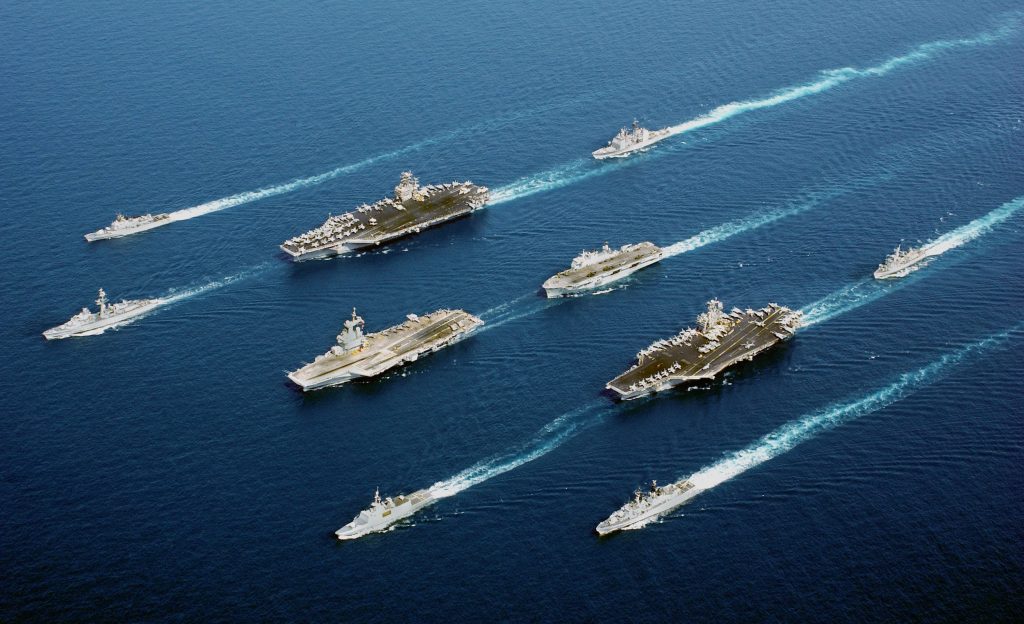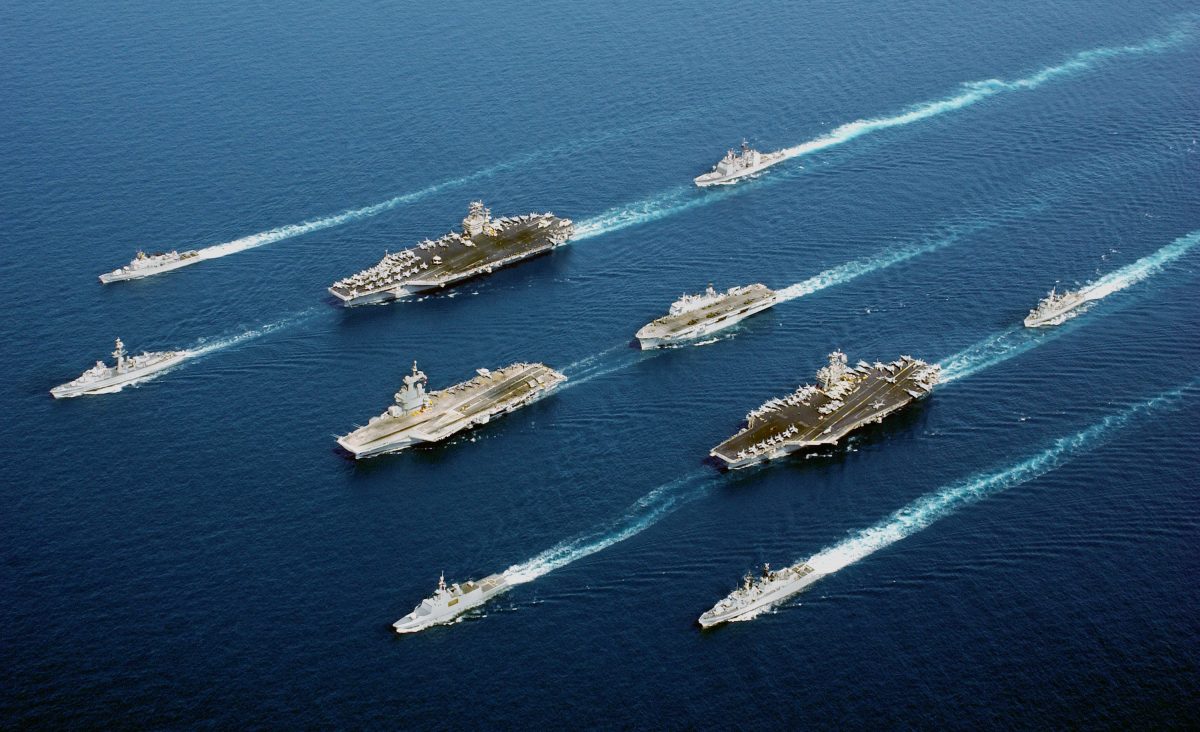
In the long tradition of Hollywood disaster movies it has often fallen to the United States Navy to rally the final defensive line, or provide the rescue platform solution to one of the world’s impending Apocalypses, with a long line of contenders for most deadly, including: ‘The Day of the Triffids’, ‘Battleship’, ‘Voyage to the Bottom of the Sea’, and the more recent “World War Z”. However, that traditional line of defence was quickly breached by COVID-19 with little difficulty. It also claimed its first Command victim in a surprisingly public manner. A US aircraft carrier captain, Captain Brett Crozier, was sacked after leaking a scathing letter to the Navy leadership, asking for stronger measures to control a COVID-19 outbreak onboard his ship, the USS Theodore Roosevelt. Although, according to media sources, the first US sailor assigned to a warship to test “presumptive positive” to the virus was a sailor stationed in Italy, and reported mid-March, whilst on the amphibious assault ship USS Boxer (LHD 4). Boxer is currently alongside at the Naval Station, San Diego, California. The United States Navy at this point began to seriously ramp up preparations to ensure the health of the US fighting fleet. However, Captain Brett Crozier, commanding officer of the USS Theodore Roosevelt, said in his memorandum that the vessel did not have enough quarantine and isolation facilities to comply with US NAVADMIN guidance.
The fallout from the ‘press release’ was that US Navy Secretary Thomas Modly replaced Captain Crozier, stating the aircraft carrier commander had exercised poor judgement by not safeguarding the memorandum, from being released outside the designated chain of command. “It raised alarm bells unnecessarily,” Mr Modly is reported to have said. Captain Crozier took this action from the viewpoint that unless the US Navy acted immediately, it would fail to properly safeguard ‘our most trusted asset – our sailors’. The unsanctioned release of the letter put the US top brass at the Pentagon on the defensive, having now to respond to allegations of whether it was doing enough to keep the warship’s crew members safe, and the raised concerns of alarmed families of those onboard the vessel, whose home port is also in San Diego. The US carrier had been on Pacific operations, docking not long before in Southern Vietnam, where there were no reported Covid-19 cases in the south of the country at that time, with the Navy reporting its first virus case a week previously. The USS Theodore Roosevelt has since docked at the US Naval Base in Guam in the Western Pacific; this followed Captain Crozier’s request, asking for his sailors to self-quarantine off the ship whilst docked in Guam. In a memorandum to superiors dated March 30 2020 he stated ‘the crew is “unable to comply”’ with Centre for Disease Control protocols, in previous Navy guidance to quarantine or social distance for 14 days. At that time 150 sailors from the US carrier were reported as infected, with none hospitalised at that point, being a small part of the ship’s company with over 4000 sailors aboard. Due to the warship’s inherent space limitation, they couldn’t do this. The spread of the disease is ongoing and accelerating he reportedly wrote. The memorandum purportedly criticised an “inappropriate focus on testing” in response to Navy leaders’ pushing to test every member of the ship’s company aboard. Captain Crozier stated: “Testing has no direct influence on the spread of the COVID19 virus. It merely confirms the presence of the virus”, which is a statement hard to refute.
Hope this naval public relations nightmare would be quickly forgotten, were dashed as one crew member of the coronavirus-infected USS Theodore Roosevelt died of complications arising in relation the disease, 11 days after the aircraft carrier’s captain was removed from command. Perhaps, history will look favourably on the captain, and justify his concerns that the US Navy had done too little too late to safeguard his crew. The sailor was the first active-duty military member to die of Covid-19. The US Navy subsequently announced that an aircraft carrier strike group led by the USS Harry S Truman, which had originally been heading home to Norfolk, Virginia from a long deployment in the Middle East, would now be kept in the Atlantic as a way to protect the crew from coronavirus. “The Navy is taking this measure to maintain the strike group’s warfighting capability while ensuring the safety of the crew,” another US Navy spokesman said in a released statement. There are at this time no known covid-19 cases onboard the USS Harry S Truman, or the other ships in its strike group.
The difficulties of keeping a ship free from the coronavirus, is not exclusively an American Naval problem, as the French Ministry of Defence announced on the 10th April that 50 personnel aboard their own aircraft carrier Charles de Gaulle had tested positive for the Wuhan coronavirus, as the vessel was heading home to France. At least 3 crew members were reported to have been airlifted from the carrier and taken to Portugal before being subsequently transported to a more secure hospital in the French city of Toulon. A team of epidemiologists were sent to the French aircraft carrier, and are now studying the spread of the virus onboard. The French aircraft carrier has 1200 crew, and 560 members of the French general staff aboard the vessel at any one time.
Such an existential threat to the wellbeing of a ship’s crew, going through the crews of such vessels like wildfire, in an age of NBCD awareness, is perhaps a little surprising. The lack of quarantine space, close quarters working, and the use of air conditioning, are all issues present since the inception of maritime platforms, but possessing significant practical implications for even one member of a crew catching the virus, and passing it on to others. This is not even a military platform specific problem, with parallels to commercial cruise and pleasure vessels, as evidenced by the 2019–20 coronavirus pandemic having spread to several cruise ships, with issues including: crowded semi-enclosed areas, shared communal eating and recreational areas, and relatively limited medical resources, which all synergistically contributed to the increased risk, and rapid spread of the disease [1]. British-registered Diamond Princess was the first cruise ship to have a major outbreak on board, and was quarantined inYokohama, Japan, from 4 February 2020 for about a month. Over 700 people became infected, and 12 people died. At the time, the ship accounted for over half the reported cases of SARS-CoV-2 outside of China [2]. Governments and ports responded to the viral threat by preventing many other cruise ships, as well as those infected, from docking and advised people to avoid travelling on cruise ships. Similarly, many cruise lines suspended operations to mitigate the further spread of the pandemic. The implications of how governments and ports will deal with foreign visiting military vessels that have an outbreak of Covid-19 onboard will likely be met with a similar response. As of 18 April 2020, over 20 cruise ships were confirmed with positive cases of coronavirus on board, and roughly 4000 passengers remain at sea on 4 cruise ships [3-4].
The arguments for lean manning and autonomous operation where possible, especially in military submarine operations, are growing in strength as time goes on. The effectiveness of a manned nuclear powered submarine, performing its stealthiest operations whilst contending with a serious outbreak of coronavirus, or a potentially worse virus, e.g. Ebola, clearly should alarm senior naval and military planners. The benefits of minimal crewing, or fully autonomous behaviour, without requirement to focus around human physiology, except perhaps for maintenance visits, is very attractive. The overall cost of modern aviation to protect a fast jet flight crew is reckoned to add over a 1/3 to the complete cost. Furthermore, crew cost savings, lack of disease and epidemiological issues, increase the attractiveness of unmanned underwater autonomous vehicle operation for most, although not all operations above and below the waterline. There are clearly temporal issues with having to come up with from scratch new build solutions. The military could do well to learn from technology transfer possibilities from the civil marine industry. Although, some autonomous marine technology developers promote concepts that involve building entirely new unmanned vessels, other companies, such as US Boston-based Sea Machines, offers commercially available systems, requiring no new vessel construction. Providing affordable retrofit options have made autonomous technologies more accessible to navies worldwide, and marine operators who cannot afford, or simply aren’t ready to add new vessels to their fleets. Autonomous command of a military vessel, more so than a civilian passenger vessel, is a highly practical technology that enhances the current navigation aids of vessels, and improves the productivity and safety of all mariners on the water today. However, if Naval forces worldwide start to embrace widespread autonomous vessel use they must ask a range of critical questions to decide precisely what it wants these platforms for, and the bottom line is the cost of such programs, given the history of naval programmes costs coming in way over budget. What type of operations will these platforms be required to perform? What will be the service provision plan that gets us from the drawing board to an operational platform? How immune will these systems be to cyber-attack, new asymmetrical threats, as well as traditional threats? The US Navy’s overarching plan is currently to build a fleet of prototypes to evaluate many hours of experimental research, whilst gaining experience operating autonomous surface vessels; and this needs to be as extensive as possible. The US Navy must establish the strengths, weaknesses, opportunities, and threats presented by unmanned autonomous platforms, and this takes time, which renders autonomy a non-solution to the current coronavirus outbreak issues.
The fundamental implementation issue in the long term is, will it work in practice? Program officials point out that autonomy is probably not the likely area of failure area where they will have the biggest issue. The biggest issue is a technical one, namely is it possible to integrate multiple complex communications suites, combat systems, missile systems, countermeasures systems, and vertical launching systems, into a single unmanned ship, which may need to operate underwater or from over the horizon, and integrate this platform within a local tactical group, whilst maintaining integrated capabilities at the strategic level as well! This will not be an easy task, as has been seen in the United States Navy’s recent long delay in fielding littoral combat ship mission modules, and other new technologies on the Gerald Ford-class aircraft carriers, which failed to inspire confidence in Washington, “The introduction of first-of-a-kind capabilities adds clearly undefined uncertainties at odds with current generations of proven aircraft carriers and their air wings.” Clearly, an optimal risk design route requires as many pre-existing standard tested systems as possible. It will be important to use existing integrated systems, and minimise the number of new components and autonomous features, as was the successful approach taken in the Lockheed-Martin design for the F117A Stealth fighter, which has proved to be a very reliable and potent aviation platform.
[1]. Kara Tardivel, Stefanie B. White, Krista Kornylo Duong (24 June 2019). “Cruise Ship Travel – Chapter 8 – 2020 Yellow Book | Travelers’ Health | CDC”. C.cdc.gov. Retrieved 12 April 2020.
[2] “Cruise ship accounts for more than half of virus cases outside China – as it happened”. The Guardian. 20 February 2020. Retrieved 5 April 2020.
[3] Erin McCormick, Patrick Greenfield and Uki Goñi. “Revealed: 6,000 passengers on cruise ships despite coronavirus crisis | World news”. The Guardian. Retrieved 12 April 2020.
[4] Impelli, Matthew. “Eight Cruise Ships Still Carrying Passengers At Sea As Coronavirus Cases Grow Around The World”. Newsweek.com. Retrieved 12 April 2020.

